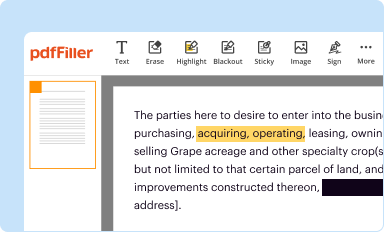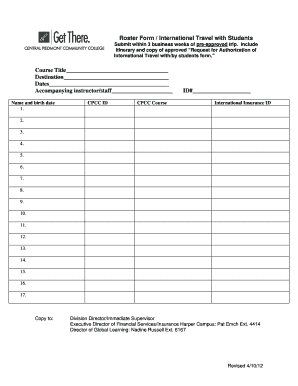
Get the free road marking codes
Show details
Road markings Across the carriageway Stop line at signals or police control Stop line at Stop sign Stop line for pedestrians at a level crossing Give way to traffic on major road (can also be used
We are not affiliated with any brand or entity on this form
Get, Create, Make and Sign road markings pdf form

Edit your carriageway markings form online
Type text, complete fillable fields, insert images, highlight or blackout data for discretion, add comments, and more.

Add your legally-binding signature
Draw or type your signature, upload a signature image, or capture it with your digital camera.

Share your form instantly
Email, fax, or share your highway code road markings form via URL. You can also download, print, or export forms to your preferred cloud storage service.
How to edit road markings highway code online
Use the instructions below to start using our professional PDF editor:
1
Create an account. Begin by choosing Start Free Trial and, if you are a new user, establish a profile.
2
Prepare a file. Use the Add New button. Then upload your file to the system from your device, importing it from internal mail, the cloud, or by adding its URL.
3
Edit road marking code form. Rearrange and rotate pages, insert new and alter existing texts, add new objects, and take advantage of other helpful tools. Click Done to apply changes and return to your Dashboard. Go to the Documents tab to access merging, splitting, locking, or unlocking functions.
4
Get your file. Select the name of your file in the docs list and choose your preferred exporting method. You can download it as a PDF, save it in another format, send it by email, or transfer it to the cloud.
It's easier to work with documents with pdfFiller than you can have ever thought. You may try it out for yourself by signing up for an account.
How to fill out road markings form

How to fill out road marking codes?
01
Familiarize yourself with the specific road marking codes for your location. These codes may vary by country or region.
02
Determine the type of road marking you need to apply. This could include lane divisions, arrows, symbols, or other markings.
03
Ensure you have the necessary equipment and materials for the job, such as paint, stencils, and measuring tools.
04
Clean the area where the road marking will be applied. This will ensure proper adhesion of the paint and a clean, professional appearance.
05
Measure and mark the designated area for the road marking, using measuring tools and stencils if necessary.
06
Apply the road marking paint according to the specific codes and standards. This may involve using special equipment such as road marking machines or brushes.
07
Allow the paint to dry completely before reopening the road to traffic.
Who needs road marking codes?
01
Road authorities and government agencies responsible for maintaining and managing road infrastructure and safety.
02
Road construction companies and contractors who are involved in building or renovating roads.
03
Professional road marking companies and contractors who specialize in applying road markings as a service.
04
Drivers and road users who rely on road markings for guidance, information, and safety. Road marking codes help ensure consistent and standardized markings that are easily recognizable and understood by all.
Fill highway code road markings : Try Risk Free
For pdfFiller’s FAQs
Below is a list of the most common customer questions. If you can’t find an answer to your question, please don’t hesitate to reach out to us.
What is road marking codes?
Road marking codes refer to a set of standardized patterns, symbols, and colors that are used to mark and demarcate roads and highways. These codes establish guidelines and regulations for road markings, ensuring consistency and uniformity across different regions or countries.
Road marking codes typically include guidelines for various types of road markings, such as centerlines, edge lines, lane markings, pedestrian crosswalks, stop lines, symbols for parking spaces, arrows for indicating direction, and other pavement markings. They specify the dimensions, colors, materials, and placement of these markings, aiming to provide clear information to drivers, pedestrians, and other road users, enhancing safety and traffic flow.
Standard road marking codes are crucial for ensuring road safety, facilitating efficient traffic management, and promoting effective communication on the road.
Who is required to file road marking codes?
Road marking codes are usually filed and enforced by the relevant government authorities responsible for transportation and infrastructure. This can vary from country to country and may involve departments such as the department of transportation, highways agency, or local transportation authorities. These authorities are responsible for developing and implementing road marking codes to ensure public safety and efficient traffic flow on the roads.
How to fill out road marking codes?
To fill out road marking codes, follow these steps:
1. Understand the road marking code: Familiarize yourself with the specific codes and regulations applicable in your region. Different countries and municipalities may have different codes, so make sure to refer to the relevant guidelines.
2. Gather the necessary information: Obtain the required details about the road marking project, such as location, dimensions, type of road, existing markings, and any specific requirements or instructions.
3. Identify the appropriate road marking symbols: Determine which symbols or markings are needed based on the purpose of the road, such as traffic lanes, pedestrian crossings, parking spaces, or bike lanes. Refer to the code or guidelines to select the correct symbols for each application.
4. Use appropriate measurements: Ensure accuracy by measuring the dimensions of the road or area where markings are needed. This may include the length and width of traffic lanes, gaps, distances to intersections, or specific markings like arrows or symbols.
5. Follow the correct techniques: Use the recommended methods for applying road markings. This may involve using stencils, templates, or equipment like road marking machines to ensure precise and uniform markings. Consider factors like paint type, thickness, reflective properties, and durability based on the code requirements.
6. Verify compliance: After completing the road marking application, check if it matches the specified code or guidelines. Ensure that the markings are clear, visible, and correctly placed, following any regulations related to colors, dimensions, or symbols.
Remember, accurate and clear road markings are essential for the safety and efficiency of traffic flow, so it's important to follow the codes and guidelines to maintain consistency and avoid any confusion for road users.
What is the purpose of road marking codes?
The purpose of road marking codes is to provide a standardized system of markings and symbols on roads and highways. These codes serve several important purposes:
1. Safety: Road markings provide essential information to drivers, cyclists, and pedestrians, helping them navigate, anticipate hazards, and make safe decisions while on the road. For example, markings indicate lane divisions, pedestrian crosswalks, stop lines, and turning lanes, ensuring proper and safe traffic flow.
2. Traffic Management: Road marking codes contribute to efficient traffic management by guiding drivers on proper lane usage, signaling traffic priorities, indicating speed limits, and conveying other regulatory information. They help maintain order and reduce congestion on roadways.
3. Consistency and Uniformity: Road marking codes ensure consistency in the application and interpretation of markings across different regions and jurisdictions. This uniformity helps drivers easily understand and follow road rules, regardless of their location, reducing confusion and potential accidents.
4. Accessibility: Road markings play a crucial role in aiding visually impaired individuals. Raised pavement markers, tactile markings, and crosswalk symbols with auditory signals allow them to navigate safely and independently.
5. Communication: Road markings serve as a means of communication between road users and transportation departments. They communicate important information such as parking restrictions, loading zones, or designated lanes for specific vehicles.
Overall, road marking codes enhance road safety, improve traffic flow, facilitate efficient transportation, and create a predictable and uniform road network for all users.
What information must be reported on road marking codes?
The information that must be reported on road marking codes typically includes the following:
1. Road marking type: The type of road marking, such as dashed lines, solid lines, arrows, symbols, etc.
2. Marking color: The color of the road marking, such as white, yellow, red, blue, green, etc.
3. Marking layout: The specific layout or pattern of the road marking, such as straight lines, curves, intersections, pedestrian crossings, parking bays, etc.
4. Marking dimensions: The dimensions of the road marking, including the width, length, and spacing of the lines or symbols.
5. Reflectivity: The level of reflectivity or retroreflectivity of the road marking, which determines its visibility during nighttime or low-light conditions.
6. Location: The specific location or stretch of road where the marking is applied, including the road name, section, intersection, etc.
7. Installation date: The date when the road marking was installed or last maintained.
8. Maintenance information: Any maintenance or repair activities carried out on the road marking, including repainting, replacement, or removal.
9. Compliance with standards: Whether the road marking meets the relevant national or international standards and regulations for traffic safety.
10. Additional notes or comments: Any additional information or observations regarding the road marking, such as visibility issues, damage, wear and tear, or any other relevant details.
It is important to note that specific reporting requirements may vary depending on the jurisdiction and the purpose of the road marking (e.g., traffic control, safety, parking regulations, etc.). Local authorities or transportation agencies may have their own guidelines for reporting road marking codes.
Can I create an eSignature for the road marking code in Gmail?
Upload, type, or draw a signature in Gmail with the help of pdfFiller’s add-on. pdfFiller enables you to eSign your road markings pdf and other documents right in your inbox. Register your account in order to save signed documents and your personal signatures.
Can I edit road marking codes form on an Android device?
The pdfFiller app for Android allows you to edit PDF files like road marking codes form. Mobile document editing, signing, and sending. Install the app to ease document management anywhere.
How do I fill out road marking codes form on an Android device?
Complete road marking codes form and other documents on your Android device with the pdfFiller app. The software allows you to modify information, eSign, annotate, and share files. You may view your papers from anywhere with an internet connection.
Fill out your road marking codes form online with pdfFiller!
pdfFiller is an end-to-end solution for managing, creating, and editing documents and forms in the cloud. Save time and hassle by preparing your tax forms online.

Road Marking Codes Form is not the form you're looking for?Search for another form here.
Relevant keywords
Related Forms
If you believe that this page should be taken down, please follow our DMCA take down process
here
.
























